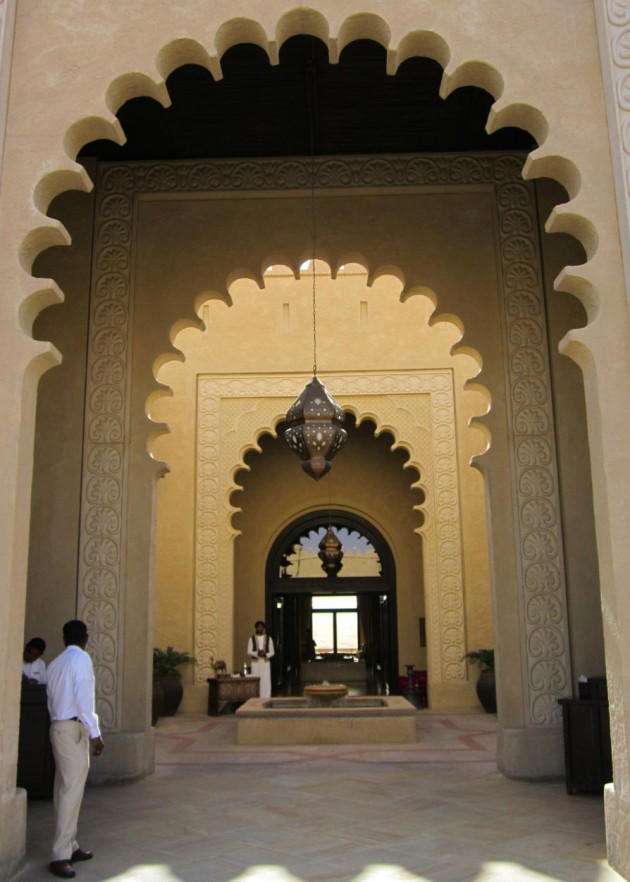
HEIDI KINGSTONE visits Anantara’s Qasr Al Sarab Desert Resort
Vast tracts of sand stretch alongside the tarmac road that leads to Saudi Arabia, where most of the Empty Quarter can be found. The drive from Dubai takes roughly three hours through part of the Rub al Khali, the longest sand desert with some of the highest dunes in the world.
The hypnotic stillness hasn’t changed in thousands of years. You half expect T.E. Lawrence to appear on the horizon astride a camel.

The Qasr Al Sarab, an ancient fortress in a timeless landscape, finally emerges as a huge edifice reminiscent of a bygone age, actually a feat of modern engineering. Qasr Al Sarab, which means palace of mirages, is set in Liwa, an oasis 240k from Abu Dhabi.
The experience starts on the long drive up a private winding road and continues on arrival with juicy dates, Arabic coffee and a delicious yoghurt drink, a welcome that embodies the spirit of Arabia.
The sound of water is ever present with fountains and streams and channels. Every detail of the hotel – each corner, alcove, wall, walkway, hall or ceiling has something to stimulate the senses. The property showcases 2500 original artefacts from the region. Lanterns line the stairs, and old weapons used in tribal warfare hang high on the walls. The ones requiring bullets are called bundoukiya.
You can find a telescope that no one seems able to work in the library, as well as books by British explorer Wilfred Thesiger. It took 10,000 workers 22 months to build the hotel, which opened in 2009. It remains a heroic 24-hour effort to sweep the sand back to the desert, and ensure that the whole complex doesn’t disappear.
Given the chance I would never have left the tranquility of the large terrace of my room. The night sky in the desert is special and Jupiter and Venus glowed like two enormous orbs. The hotel has put five semi-spherical drums around the 2km property and you can see the constellations and chart the course of the stars and planets. One corporate sponsor brought out an astronomer for his guests, a brilliant idea but at £5000 an hour, perhaps not for everyone.

The next day I was wrested from my bed for a 6:15am dune walk. You sense the unremittingly harsh Bedouin life but today few Bedouins with their camel caravans roam any more. The sand sea stretches to the borders of the UAE, Yemen, Qatar, Oman and is only 25k from the eastern reaches of Saudi Arabia.
Wildlife comprises oryx, sand rabbits, sand vipers, and huge camel spiders that shoot venom into the camel before chomping away at the flesh. You can see the tracks left by snakes and other creatures. At the end, coffee and croissants take the sting out of the exhausting climb.
The hotel offers camel trekking, dune bashing, falconry and archery, but I chose yoga on the dunes at sunset. Yam, the instructor, took me through a series of Hatha and Hathastanga moves, working the core muscles. Lying down at the end with arms outstretched, the soft velvety sand felt fabulous and acted as good exfoliant.

Arabic decor runs throughout the 154 rooms, 42 villas, and 10 self-contained royal villas or mini palaces. Sheikhs and sheikhas arrive via helicopter with their own chefs, and stay in their ultra-luxury compounds. The ruler of the UAE, as well as many other international dignitaries have used the Royal Pavilion.
Any of the four restaurants serve local dishes or a range of international cuisines. The first night we tried some local dishes – a real feast. The service was impeccable. Indeed, the consensus was the only area that could be improved was the kitchen.
Anantara is taken from the ancient Sanskrit word meaning ‘without end’, and is also the name of the Thai hospitality operator. Traditionally in Thailand people would leave a jar of water outside their house to provide refreshment to the passing traveller.

